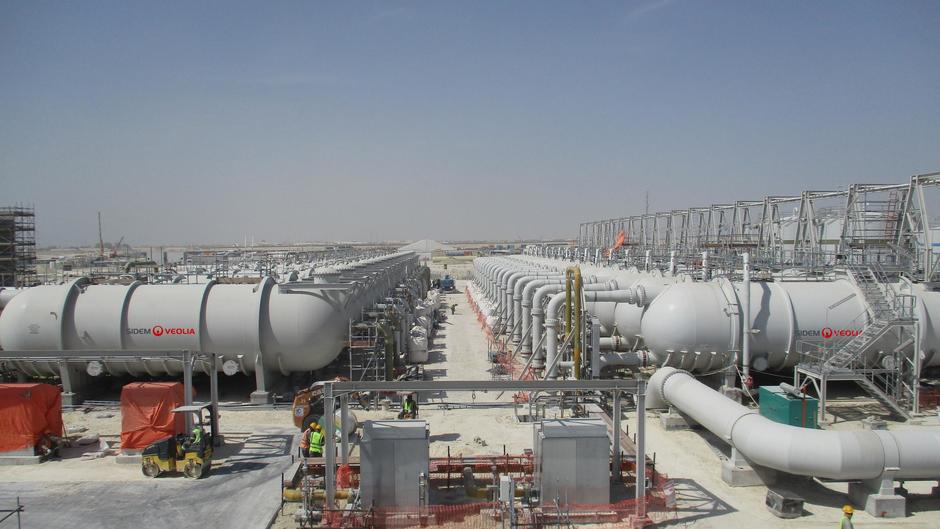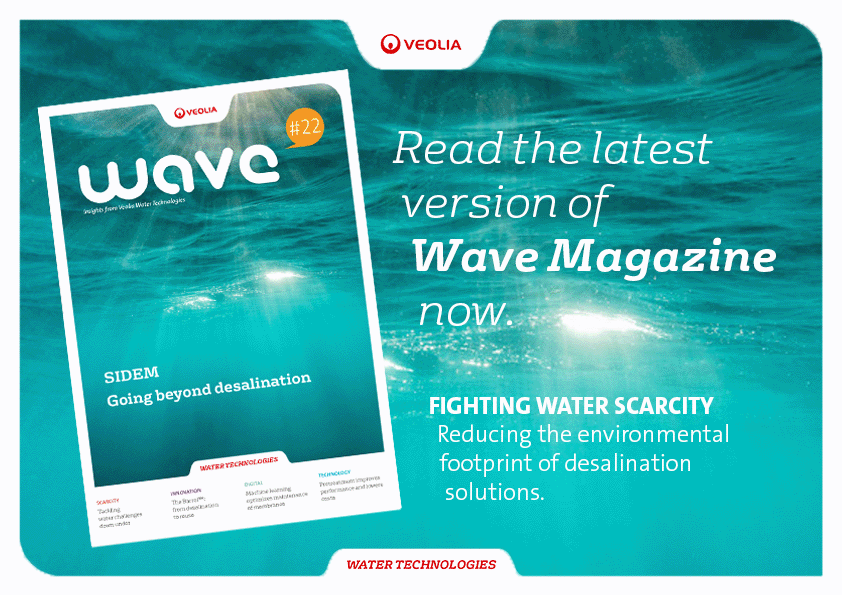Located on the southeast coast of the Kingdom of Bahrain, Al Dur 1 is an independent water and power project —producing 1,234 megawatts (MW) of electricity and 218 000 cubic meters ofdesalinated water per day — which began commercial operations in February 2012.
Following the success of Al Dur 1, and to help combat the ongoing water stress in the region, a second adjacent project, Al Dur 2, was awarded in 2019. Its mission was to generate an additional 1,500 MW of power and produce 227 000 cubic meters of water utilizing state-of-the-art seawater reverse osmosis (SWRO) technology.
Two years later, the Al Dur 2 SWRO sister plant has been designed and built by SIDEM — a Veolia Water Technologies subsidiary. It consists of two independent production streams that ensure more than one million residents have access to safe, low-risk, potable water necessary for their development and well-being.

Responsible for the assignment, Project Director Jean-Baptiste Schmitt shares with us what makes the plant unique, reveals key milestones and team achievements, and discusses how seawater desalination is an effective means of combating water scarcity in arid coastal regions.
What makes Al Dur 2 so unique?
“It’s the way the site was designed, built, and is now optimized that makes it incredibly efficient. It has been carefully mapped out from A to Z to help reduce its carbon footprint by combining cutting-edge technologies and ongoing in-house expertise.

"For example, in pretreatment — where we filter the water extracted from the sea — we’ve used two patented technologies, our dissolved air flotation (DAF) filter and dual media pressure filters (DMPF) with integrated cartridge filters, to guarantee the removal of high turbidity and suspended solid particles. This holds primary importance since it facilitates smoother operations and supports the overall efficiency of the plant.
Another example is when the water enters the heart of the desalination plant: the reverse osmosis system. Here the water is pushed under high pressure through a membrane that retains up to 95 percent of the salt particles and 99 percent of all other impurities. Our inhouse experts ensure this high-pressure pump, which is where most energy is consumed, is optimized to significantly improve plant efficiencies and lower energy consumption.”
What were the main challenges associated with managing such a large-scale project and how did you overcome them?
“At peak capacity, there were 1,200 people working on site. The large multi-cultural team was required to achieve the completion of the first half of the plant (113,500 cubic meters a day) and put it online after only 22 months. This required precise organization, the knowledge and experience of everyone on the team, and a unified goal of meeting our targets.
We set up higher safety objectives than the ones required by our client and achieved 5.2 million working hours without incident with our ‘Always-safe’ mindset. Considering most of the work took place during the height of the COVID-19 pandemic, safely completing such a huge project in record time is, in my opinion, our greatest achievement.”
The production of desalinated seawater in the Middle East is projected to increase almost fourteen-fold by 2040. What are the major trends shaping this growth?
“Water consumption in Bahrain has been on the rise for the past ten years and is forecast to continue owing to steady population growth and the impacts of climate change on their natural resources. The country is looking at not only increasing its capacity but doing so sustainably. There is a huge focus on innovation to make vital processes like seawater desalination less energy intensive and we’re seeing a greater focus on renewing existing assets and upgrading to smarter, more efficient systems.”
How important a role does sustainable development play in shaping this growth? And how is Al Dur 2 environmentally related?
“Today everyone understands that our everyday resources are neither free nor infinite, and the carbon footprint of energy and water production has to be drastically reduced. The government of Bahrain has recognized this and has taken a number of critical steps to shift the country towards more efficient energy consumption and water production as part of its 2030 vision so sustainable development is undoubtedly a major trend.
Seawater desalination is an effective way of securing water in arid coastal areas and for countries like Bahrain, which is listed among the top ten countries likely to suffer from a water crisis in the next 25 years, desalination plants are vital. The good news is if we compare the technologies used traditionally in seawater desalination plants 10 years ago to the technologies of today, we are already saving 300,000 tonnes of carbon dioxide (CO2) equivalent annually — equal to flying around the earth 32 times.
In that respect, the Al Dur sister sites represent the first in a series of desalination plants that will continue to help Bahrain meet its power and water needs in a more sustainable way, in line with the country’s carbon footprint reduction policies.”



